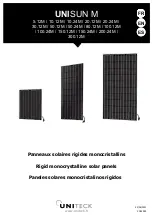
Use #0 gauge wire to make the connections to the Inverter, may require a "0 to 4 Gauge Adapter".
This adapter is available through most electrical supply stores. Heavy gauge cables sold
separately.
Connections
Make sure the ON/OFF Switch located on the front panel of the Inverter is in the OFF (O) position.
1.
Connect the wires to the power input terminals at the rear of the Inverter. Make sure to
match the negative (BLACK) terminal on the Inverter, with the wire that connects to the
negative terminal on the 12 volt power source. Then repeat this procedure with the
positive (RED) terminal, connecting a wire to the positive terminal of the 12 volt power
source. Make sure you have a good (clean), secure connection, but do not over tighten
these screws.
2.
Locate the Ground Lug Terminal at the rear of the Inverter. Run a wire from this
terminal to a proper grounding point using the shortest practical length of 8 AWG wire.
You can connect this wire to the chassis of your vehicle or to the grounding system in
your boat. When in remote locations the ground wire can be connected to the earth
(one way to accomplish this is to attach it to a metal rod driven into the ground). Before
connecting the ground, make certain that the Inverter is turned off.
Operating the Inverter without correctly grounding the unit may result in electrical shock.
3.
When you have confirmed that the appliance to be operated is turned off, plug the
appliance into one of the 110V AC Outlets on the front panel of the inverter.
NOTE Loose connections can result in sparks, and a severe decrease in voltage caused
by contact resistance which may cause damage to the wires and insulation from heat
generation at the poorly contacted terminal.
When making the connection to the inverter, the
following sequence is recommended.
1) Connect the Negative cable to the Negative terminal post on the battery.
2) Connect the other end of the Negative cable to the Inverter Negative terminal.
3) Connect the Positive cable to the battery post.
4) Connect the other end of the cable to the inverter Positive terminal.
This last connection may cause a spark. This is a result of current flowing to charge
capacitors within the Inverter. This is a normal occurrence.
The audible alarm may make a momentary "chirp" when the Inverter is turned OFF (O). This
same alarm may also sound when the Inverter is being connected to, or disconnected from the
12 volt power source. When using an extension cord from the Inverters to the appliance, the
extension cord should be no more than 50 feet long. At this length there should be no
measurable decrease in power from the inverter.
The inverter comes equipped with a cooling fan. An automatic shut down of the unit caused by
high circuit temperatures, will occur when the cooling fan is unable to maintain a cool enough
temperature for safe operation. In the event of automatic shut down or a continuous audible
alarm, turn the inverter power switch to the OFF (O) position until the source of the problem has
been determined and resolved. Inexpensive sound systems may emit a "buzzing" sound, when
operated with an Inverter. This is due to the inadequate filters within the sound system. There is
no solution to this problem.
Source of power
Automotive and Deep cycle batteries are good at delivering moderate power (300 watts) for a
reasonable period of time. They can also deliver High power (5000 watts), but for a short period
of time. This is because of the internal chemistry of the battery (water gets produced on the
plates faster then it can be absorbed in the electrolyte and acts as an insulator, increasing
















































